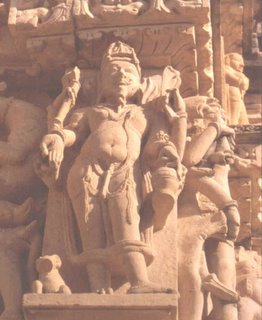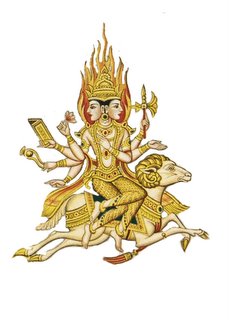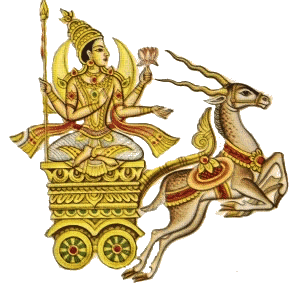
(Images from here, here, here and here)
Shiva Family, Gaya, Bihar, India, 10th Century, Early BronzeStone Sculpture-LOS Angles CCU Museum of Art, Calfornia
Dear readers,
Moon had just entered Ashlesha Nakshatra (11th. February 2006 evening, Chicago, USA) and I was hunting for answers, answers to a question I posted in numerous forums of learned scholars but did not receive any satisfactory answers.
Ananta Seshnag (the God of Ashlesha Nakshtra) must have had mercy on me and I found Rodney Lingham born under Ashlesha Nakshatra.
His work is in one word nothing short of pure genius.
A very elevated soul and a pure genius with his novel research he has answered my age old question.
Why was Shiva ignored in Rig Veda and finds mention only as mere storm god Rudra?
Does that mean that Aryan invasion theory of western researchers are true but the dates doesn't make sense if we have to believe the dates of Ramayana?
These and many other questions came out crystal clear after reading Ligham's website. I have also put a link to Rodney's website on my blog. I strongly recommend truth seekers to visit his website and appreciate his work.
I also interacted with him personally and congratulated him on his great work.
The humbled soul has willingly accepted my request of putting some of his articles on my blog.
His articles on Shiva reconfirmed my believe in the fact that there is nothing that is not Shiva, all that is is Shiva, all that is not is not!
Na mrityur na shanka na jatibhedah
Pita naibo main naibo mata na janma
Na bandhurna mitrang gururnaibo shishyah,
Sachchidanandarupa Shivohom Shivohom
Na punyong na papong na shaukhyong na dukhong
Na mantro na tirtha na vedah na yagah
Ahang bhojanang naibo bhojyong na bhokta
Chidanandarupah Shivohom Shivohom
Pita naibo main naibo mata na janma
Na bandhurna mitrang gururnaibo shishyah,
Sachchidanandarupa Shivohom Shivohom
Na punyong na papong na shaukhyong na dukhong
Na mantro na tirtha na vedah na yagah
Ahang bhojanang naibo bhojyong na bhokta
Chidanandarupah Shivohom Shivohom
Shivoham Shivoham!
Souvik
FORMS OF SHIVA FROM THE VEDAS:(The Secret Wisdom of Indra Agni and Soma)
Indra, Agni and Soma are the Three Forms of Rudra (Shiva) in the Vedas.
Indra is Tamas (Darkness or inertia), and relates to the highest forms of Shiva.
Agni is Rajas (Passion) and relates to the Fiery Quality of Tapas and Rajas, Passion.
Soma represents the Truth and is Sattva-Guna.
These are also the Three Qualities of Brahman (Shiva) as:
Sat (Truth) or Indra
Chid (Consciousness) or Agni
Ananda (Bliss) or Soma.
The Three Forms of Shiva here, constitute his Three Heads.
This is seen in the Three Heads of Agni, the Chid (Consciousness) form in Vedas or Rudragni (I.46.1). This later becomes Trimukeshvara (The triple-faced lord).These Three Forms thus become apparent in the avatars or forms of Shiva, according to the modes.
Wrathful forms or avatars as Mahakala, Vajradhara, Bhairava, Rudra, Virabhadra, Pashupati, Aghora, Sarabheshvara etc. are the more Indra category, as the Supreme Form of Shiva that represents Tamas - but the Highest Tamas as Sat (Truth), that transcends all of Maya and goes beyond.

Sundara, Ushanas (Asuramaya), Vishnu (Sadashiva), Dakshinamurti, Shankara, Shambhu etc. represent the more Auspicious sides of Shiva, and form the Soma or Bliss Category. Often these forms of Shiva represent the Crown Chakra, Wisdom, Youth and Beauty of Lord Shiva. They are the more Sattva forms.
 Yogeshvara, Skanda, Ganesha, Brahma, Yogeshvara, Goraksha etc. forms of Shiva represent the more Agni or Chid (Consciousness) forms of Shiva, as the Lord and Master who represents the Inherit Wisdom in Nature, and Control. It also incorporates the Quality of Rajas - but also the Control of Rajas, as in Tapas, and thus connects to Yoga and Wisdom forms.
Yogeshvara, Skanda, Ganesha, Brahma, Yogeshvara, Goraksha etc. forms of Shiva represent the more Agni or Chid (Consciousness) forms of Shiva, as the Lord and Master who represents the Inherit Wisdom in Nature, and Control. It also incorporates the Quality of Rajas - but also the Control of Rajas, as in Tapas, and thus connects to Yoga and Wisdom forms. Brahma and Skanda are here also, as Fire and Rajas forms of Shiva - Qualities of Action. It is the Child of Shiva, Guru.

The Agni or Chid-form also relates to the decent of Consciousness of Shiva, and thus his Human-avatars, as Rishis or Seers, like Agastya, Vasishtha, Goraksha, Dattatreya, Shankara etc. as will be explained later. He is Shiva the Human/Godly Teacher, whereas Soma is the Celestial and Adhyatmic Teacher beyond Ritualism.

Soma or the Ananda, Sattva and Sahasrara form of Shiva is known as Sadashiva (Vishnu) or Parashiva in Agamic texts.

The Agni or Chid-form also relates to the decent of Consciousness of Shiva, and thus his Human-avatars, as Rishis or Seers, like Agastya, Vasishtha, Goraksha, Dattatreya, Shankara etc. as will be explained later. He is Shiva the Human/Godly Teacher, whereas Soma is the Celestial and Adhyatmic Teacher beyond Ritualism.

Soma or the Ananda, Sattva and Sahasrara form of Shiva is known as Sadashiva (Vishnu) or Parashiva in Agamic texts.
He is the Supreme Source and origin of all, and thus personifies the Highest Abode of Shivasvarga (Shiva Heaven) in the Sahasrarapadma Chakra (Chakra with a Lotus of a thousand petals) or Soma Chakra.


These ideas of Parashiva (Soma), as the Supreme Source, are also found detailed in this aspect, as both a God and Chakra, meaning the same as Agamas in Rig Veda:
" [O Soma!]Father and generator of the gods, the skillful, the Pillar of the Heavens (ie. Linga), and supporter of Earth. Rishi and Illuminated Sage, greatest of people, apart and wise, Ushana (Shukracharya) in knowledge" (Rig Veda .IX.87.2-3)
"Father of sacred chants, Soma flows onwards, the Father of the Earth, Father of the Celestial region: Father of Agni,(Skanda) the creator of Surya,(Brahma) the Father who gave birth to Indra (Shiva) and Vishnu" (Rig Veda.IX.96.5)
Again, Soma here is Parashiva or Sadashiva, often identifies with Vishnu as a form of Shiva, the Primal Source of all Creation, Gods, Worlds and Beings. It is this highest abode that we seek top reach, and unite with Sundara Parashiva and his consort Lalita - both personifications of this Soma or Sahasrara region or Chakra - known as Satya Loka (Region of Truth) in both Vedic and Tantric texts alike.
The teacher of the Somavidya or Doctrine of the Vedic Soma-Wisdom that relates to that abode, is Rishi Dadhyak in the Vedas, who teaches through the Head of a Horse.
This idea later became apparent in Agamic and Tantric texts, where he is the Horse-faced Hayagriva is the great Seer and Teacher of the Shrividya tradition of Lalita and Sundara to Sage Agastya.Agastya himself, is actually Seer of the Love-Goddess Rati in Rig Veda, and also of the Goddess Rodasi - both who also relate to the Blissful Forms of the Goddess and Gods in later times which derived from Soma. Likewise, Sundara and Lalita are also called deities of love - Kameshvara and Kameshvari.
Soma is also the Shakti-form of Shiva as it relates to Maya and the Moon - the Ida Nadi on the Left of the Body. Yet, as the vigour of Indra, the powerful forms of Shiva, it is also Indra-Shiva's "Shakti", and thus Soma = Shakti in many respects, also. As does the Vajra (Thunderbolt), which later changes to become Shiva's Trishula (Trident), Shakti-astra (Weapon of power) etc. and why Shiva is Shaktiman. Shakti is thus as much an integral part of Vedic forms of Shiva (as Indra) as it is in later times - which allows him to defeat the Demons through possession of it.Agastya is a great Seer of the Indra form(s) of Shiva and the Maruts or Rudras (Yogis, Nathas and forms of Shiva in Human and Divine forms) in Rig Veda also, especially Mandala I.
His brother, Vasishtha, is the Seer of the great Shaivite Mahamrityunjaya Mantra of Rudra (Rig Veda.VII.59.12) - often addressed to Shiva as Mahakala, who takes us beyond the snares of the God of Death and Creation, or the Mayaic (Illusionary) World, and helps us physically and psychologically transcend all.Thus, the Rig Veda is the "Shiva Agama", which addresses Shiva's forms and characteristics in much simpler Yogic fashion, much like the Agamas and Tantras of later times, which also do, as opposed to the more Mythological Puranas and such texts. Thus, as in Tantra, in the Vedas also, does Shiva in his many forms as explained above, take on a more personal and intimate role, especially in Rig Veda.
Indra saves the Vedic Kings Yadu and Turvasha from the Flood in Rig Veda (VI.54.1), and as Agni-form (Chid), he is the Saviour, Mother and Father (VI.1.5) or Agni as the Deliverer across he Ocean (I.99.1). Agni is first of Angirasa Seers (I.31.5), the auspicious friend, which connects again to Shiva as the avatar. Here we see Agni-Shiva as the teacher who takes us beyond all miseries as the Guru.
Indra form of Shiva is also called the friend of the Munis (VIII.17.14), to Indra the Cosmic Lord (Rig Veda.VIII.87.2, Rig Veda.II.22.1), and Indra the father or mother and who grants bliss (Rig Veda.VIII.87.11).
These relate to the Powerful Form of Shiva as Ishvara, who has the Supreme Yogic Power to take us to the ‘Great Beyond’.The Vedas are thus not texts about merely Nature-worship, but worship of Higher Cosmic Principles, of which the Natural Elements and Forces in Nature are themselves lower physical reflections of, in the realm of Maya, or Creation, as a mirror image.
Agni is our Inner Divine Friend and Remover of Woes; Indra is our Inner Warrior and Soma is our Inner Vigour and Wisdom.
With these Three, we become the Paramatman (The Supreme Self) and transcend all dualities - become Shiva and live in the world, and be not part of it. Shiva or Indra is hence the Lord of Non-Dualism and Detachment.The Vedas are thus texts of Spirit. Surya, Vayu, Varuna etc. all have higher Cosmic Meanings. Varuna for example is Lord of Primal Waters, and connects to the Demiurge and Cosmic Serpent, which lies in Svadishthana Chakra in the lower body. Vayu is the higher Cosmic Prana or Breath of Life, and also Yogic Forces of Vayus, and Surya is the Brahman-principle as the Inner-Sun which is the Soul or Atman, the Light-form of Shiva as Ishana that becomes all and pervades all of nature as Vaishwanara or Narayana.
Vedic names for Gods also have higher meanings, often relating to Yogic Powers and Yoga. Gopati, "Cow Lord", a common term for forms of Shiv as Indra, Agni and Soma - also means "Lord of Lights", meaning Jivas or Souls, and also Lord of Sense-organs (Indriyas).
The Vedic Gods are all Yogic Lords, ever-willing to aid us in the control of Senses or Pranas and to transform our being. The Seven Gods, Pranas, Horses, Wheels on the Vedic Chariot etc., for example, are representative of our subtle pranic centres, known as Chakras (Wheels) or Padmas (Lotuses) - the Seven Suns or Sun-Gods, and as Rishis are Pranas, the Shaktis of the Chakras in later Tantric texts.
Shiva the Lord of Spirit and Transcendence then, pervades the Vedas, and is best represented by the Vedic Gods, of whom are his powers and forms that we identify with on a personal and cosmic level. As Rig Veda states, there is One Truth, but with many names (I.164.46; I.2) and, realising this, we become all the Seers and the Supreme, Realising our Unity with the God-born forefathers of yore, as Indra-Shiva himself (RV.IV.26.1).In doing so, we begin to see the Primal Being as all-pervasive in the Cosmos (as in RV.I.89.1), as mother, father, son, heaven, earth and the five races (or five castes: brahmin, kshatriya, vaishya, shudra and chandala or outcaste). This is Shakti, which is the divine feminine form of Shiva himself in the form of Maya, which helps us to understand all people, cultures, beings, worlds and planets as essentially one family.It is Shiva in his many forms who is the Lover (Mitra) and Friend (Sakha), Eternally Present for us. Seeing all Creation as him, we see that our lives and occurrences are his mere Lilas or Plays.
Yet, with his aid, we can transcend these - the jobs of his expansions as the Vedic Gods.This shows that Shiva is very much a Vedic God, and refutes the idea of him as a pre-Aryan and non-Vedic God. His other ‘Aryan’ or Indo-European counterparts, such as Bacchus in Rome, Cenunnos amongst the Celtic Druids and Dionysus amongst the Greeks, also shows the existence of a Supreme Non-Dualistic deity, that was rejected by the Judeo-Christian traditions as ‘Satan’.
His horns symbolised the crescent-moon, which were his symbol of immortality, the night and hence relating to the idea of tamas or transcendental darkness, beyond creation and the un-manifest reality. The Moon is also the symbol of Soma, and hence wisdom and immortal delights (amrita-ananda).Verily, the path of Shiva, the auspicious one, is the noble (arya) path!


No comments:
Post a Comment